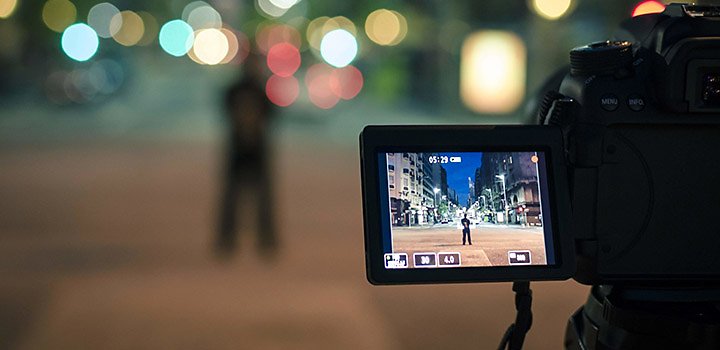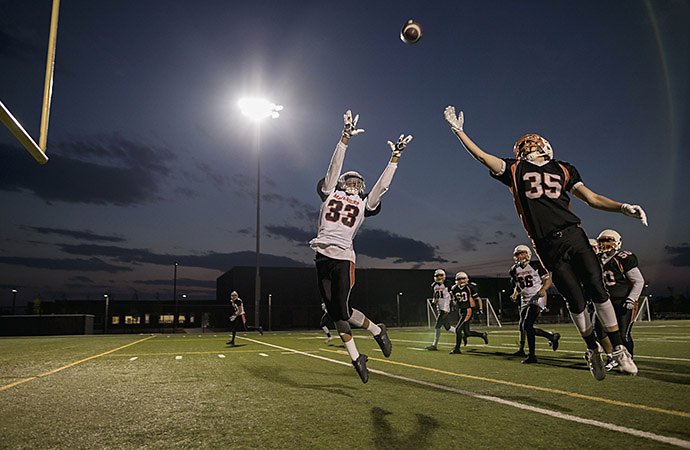The importance of frame rate in moviemaking.
Whether you want to create short independent films or be the next Peter Jackson, an understanding of frames per second or FPS will help you to ensure your work gets the proper viewing experience.

What is frame rate?
To the human eye, film and video seem to play as one continuous recording. But in actuality, cameras record pictures of multiple images, called frames. These frames are played back at such a fast rate that they appear to be in fluid motion. Frame rate is the measurement of how quickly a number of frames appears within a second, which is why it’s also called FPS (frames per second).
Motion pictures, TV broadcasts, streaming video content and even smartphones use the standard frame rate of 24fps. This speed accounts for a phenomenon called motion blur, an optical effect that makes moving objects look out of focus due to quick movement.
“If you were at a baseball game and someone hit a ball, you would see a little bit of a motion blur,” director Margaret Kurniawan explains. “You don’t see things totally clearly. So at 24 frames per second, it shows that there’s a little bit of motion blur, but most things are clear enough that it makes logical sense in your mind.”
A brief history of frame rate
In the early days of films, film wasn’t responsive enough to capture the short exposures needed to show motion fluidly. That's why photography subjects in the 1800s had to stand still for long stretches of time to get their picture taken. In the late 1880s, technical progress in film meant a higher number of frames could be captured by hand cranking a roll of film through the camera. This led to different frame rates being used throughout the industry, with films ranging from 14 to 26fps. This meant that real-time movement was not captured consistently. Mechanical cranks were eventually added to film cameras to stabilise the recording process. However, many filmmakers preferred to shoot specific scenes in different frame rates for different cinematic effects, like the super fast motion of a Charlie Chaplin film, leading to industry-wide irregularities.
The move to the 24fps standard.
Two significant factors prompted the adoption of 24fps as the industry standard: the advent of sound synchronisation and TV broadcasts. Earlier attempts to incorporate sound into film proven unfruitful, but by the late 1920s, the phonograph and similar inventions allowed Hollywood to sync audio during playback, starting with 1927’s The Jazz Singer. As image and sound in film became synonymous, filmmakers began to move away from the 16fps of the silent film era to 24fps, which was the best frame rate for sound comprehension while using the least possible amount of film.
In the fifties, 30fps became the norm for analogue TV broadcasts in North America, Japan and South America. At the same time, Europe and Africa adopted 25fps due to the different video formats based on hertz power, the NTSC and PAL, respectively. Modern television shifted away from these formats in recent times due to digital conversion, but the NTSC and PAL standards are still in use in the film and television industry. “A lot of times when I work on a project that’s European-based, they’ll say, ‘Just make sure to shoot in PAL mode,’” cinematographer Hiroshi Hara says.
How shutter speed and frame rate connect.
Frame rate and shutter speed are often mistaken as interchangeable. They aren’t, but they do share a close relationship. Shutter speed is a measurement in seconds of how long the shutter (which controls how much light is allowed into the camera) is open. The faster the speed, the lower the amount of light exposed to the film or digital sensor. There are many different types of shutters, from focal-plane shutters (found on DSLRs) to leaf shutters (found on medium to large cameras). However, for video, the most common shutter is an electronic one, though film cameras still use rotating discs for their light control. Electronic shutters have the ability to set higher or lower shutter speeds, in comparison to manual shutters, which must be physically attached. As a rule, to obtain realistic movement that the human eye is used to seeing, the shutter speed needs to be twice the frame rate.

Shutter angle versus shutter speed.
The rotating disc is the most often used type of shutter in the film industry. It has a single constant shutter speed and, instead of changing the speed, filmmakers adjust the shape or angle of the shutter by 15-degree intervals. The larger the angle, the more light can pass through.
Similar to shutter speeds, the ratio between angle and light is interrelated. Divide or multiply the angle and it will do the same to the light. Most film cameras use shutter angles ranging from 0 to 180 degrees. At 180 degrees, you get the cinematic look we recognise from the big screen, as it correlates to precisely half the time that each frame takes to play in one second. “They realised at 24fps, a 180-degree shutter angle gives you the best motion blur that looks realistic,” Hara says.
Shutter angle is also the reason that, when filming at a higher frame rate, creators will need to account for more lighting to achieve the same exposure as shooting at a lower frame rate.
When to use different frame rates.
Most video content uses the standard frame rate of 24fps, but when would you use a higher frame rate or a lower frame rate? It depends on what you want to record or the effects you want to incorporate into your work.


- 24fps: Films, streaming video content (to account for a discrepancy in connection speed) and video game captures use this speed to achieve that classic cinematic look.
- 30fps: Live TV broadcasts (sports and news) and most TV shows use this speed to increase their quality. Sports, in particular, need to show movement more clearly and in real time, which is why 30fps is the frame rate of choice.
- 60fps: As 4K video resolution becomes more prevalent, a broader audience has been introduced to this FPS. 4K resolution lets a higher frame rate be displayed and gives the footage an amazingly detailed and life-like view. Perfect if you want to record a video game, this frame rate also increases the smoothness of action.
- 120fps and above: This speed produces slow-motion video and captures video games with fast and furious action (fighting, shooting, sports games). Going higher than 120fps, a rare occurrence for most filmmakers, will require a high-speed camera to make the footage look natural and smooth.
Determine the type of project you want to make before you start. This will help you to make the right decision about which frame rate to use. Each speed has its pros and cons, but all of them can help you in your journey to create something spellbinding. Discover more about frame rates and sequencing or combine multiple frame rates together to create your own distinctive style.
Contributors
Do more with Adobe Premiere Pro.
Make visually stunning videos virtually anywhere — for film, TV and web.
You might also be interested in…
Learn about the dynamic range of your camera and how to manipulate it to create the images you want.
Explore how audio bitrate relates to audio quality and user experience.
Discovering the subtlety of cinemagraphs.
A cross between a photo and video, cinemagraphs are an intriguing new artistic tool.
How to compress videos to share on social media.
Learn how to use Adobe Premiere Rush to reduce file size and export videos.
Get Adobe Premiere Pro
Create flawless productions with the industry-leading video editing software.
7 days free, then NZ$44.51/mo. incl. GST



